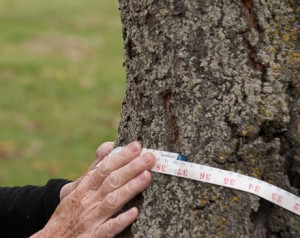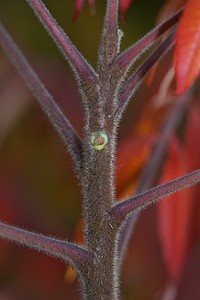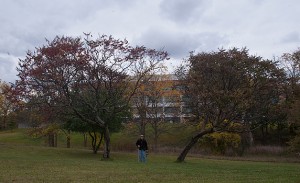Big tree hunting is a great sport. Many people find and report large trees but it is the largest of the normally small species that have always interested me. Record small tree species include a 5-inch diameter Witch-hazel, a 6-inch diameter Highbush-cranberry, a 7-inch diameter Red Elderberry, and an 11-inch diameter Pawpaw. Most people walk by trees that are less than a foot in diameter without ever thinking “big tree.”
Recently I found two large Staghorn Sumacs (Rhus typhina) on the campus of Oakland University in Rochester, Michigan. They are along Pioneer Drive southeast of Pawley Hall. The largest one is approximately one foot in diameter. Staghorn Sumac is a common species in Michigan that normally is just shrub size. It gets the name “staghorn” because the hair on the twigs resembles the velvet on the horns of a stag.
These two are not Michigan state champion size but are close. Champions are determined by a point system. The points equal the height in feet, plus the girth in inches (four-and-a-half feet from the ground), plus one-fourth of the average spread. The Michigan state champion Sumac scores 72 points. I measured the height of the largest Oakland University Sumac as 20-feet (by the stick method), its circumference at 4-feet above ground as 37-inches (the tree forks below the four-and-a-half-feet height) and its canopy spread at 26-feet x 23-feet. It scores 63 points. Currently there is no national champion Staghorn Sumac. National champions must be measured every ten years and our state champion’s data is older. The Oakland tree might qualify as a national champion.
The stick method to estimate tree height involves simple triangulation. You hold a straight stick perpendicular to the ground with your arm parallel to the ground and your hand level with your eye. The height of the stick above your hand must equal the distance from eye to the base of the stick. This forms a right triangle with two 45-degree angles. Position yourself so that when you sight over the top of the stick you see the top of the tree. The distance you are from the tree equals the approximate height of the tree.
The Michigan Botanical Club maintains the state’s big tree list and their website explains methods for measuring trees. The group American Forests maintains the national registry.
You never know what you will find in the natural world by just keeping your eyes open.
Note: Both of these trees have been removed. Updated 8/10/2021



